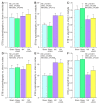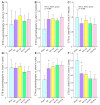Unfavorable Reduction in the Ratio of Endothelin B to A Receptors in Experimental 5/6 Nephrectomy and Adenine Models of Chronic Renal Insufficiency
- PMID: 32023824
- PMCID: PMC7037353
- DOI: 10.3390/ijms21030936
Unfavorable Reduction in the Ratio of Endothelin B to A Receptors in Experimental 5/6 Nephrectomy and Adenine Models of Chronic Renal Insufficiency
Abstract
Chronic renal insufficiency (CRI) is characterized by increased endothelin 1 (ET-1) synthesis. We studied rat kidney endothelin receptor A (ETA) and receptor B (ETB) expressions after 12 and 27 weeks of 5/6 nephrectomy, and after 12 weeks of 0.3% adenine diet, representing proteinuric and interstitial inflammation models of CRI, respectively. Uric acid and calcium-phosphate metabolism were modulated after 5/6 nephrectomy, while ETA blocker and calcimimetic were given with adenine. Endothelin receptor mRNA levels were measured using RT-qPCR and protein levels using autoradiography (5/6 nephrectomy) or ELISA (adenine model). Both 12 and 27 weeks after 5/6 nephrectomy, kidney cortex ETA protein was increased by ~60% without changes in ETB protein, and the ETB:ETA ratio was reduced. However, the ETB:ETA mRNA ratio did not change. In the adenine model, kidney ETA protein was reduced by ~70%, while ETB protein was suppressed by ~95%, and the ETB:ETA ratio was reduced by ~85%, both at the protein and mRNA levels. The additional interventions did not influence the observed reductions in the ETB:ETA ratio. To conclude, unfavorable reduction in the ETB:ETA protein ratio was observed in two different models of CRI. Therefore, ETA blockade may be beneficial in a range of diseases that cause impaired kidney function.
Keywords: calcium; chronic kidney disease; chronic renal insufficiency; cinacalcet; creatinine; endothelin receptor A; endothelin receptor B; paricalcitol; phosphate; sitaxentan; uric acid.
Conflict of interest statement
The authors declare no conflicts of interest.
Figures




References
-
- Heerspink H.J.L., Parving H.H., Andress D.L., Bakris G., Correa-Rotter R., Hou F.F., Kitzman D.W., Kohan D., Makino H., McMurray J.J.V., et al. Atrasentan and renal events in patients with type 2 diabetes and chronic kidney disease (SONAR): A double-blind, randomised, placebo-controlled trial. Lancet. 2019;393:1937–1947. doi: 10.1016/S0140-6736(19)30772-X. - DOI - PubMed
-
- Vaneckova I., Hojna S., Kadlecova M., Vernerova Z., Kopkan L., Cervenka L., Zicha J. Renoprotective effects of ET(A) receptor antagonists therapy in experimental non-diabetic chronic kidney disease: Is there still hope for the future? Physiol. Res. 2018;67:S55–S67. doi: 10.33549/physiolres.933898. - DOI - PubMed
MeSH terms
Substances
Grants and funding
LinkOut - more resources
Full Text Sources
Medical

